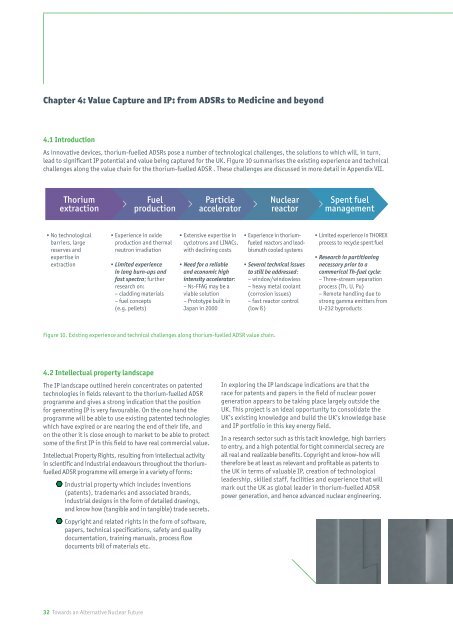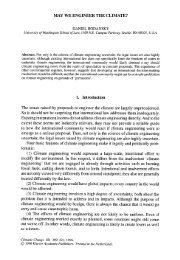ThorEA - Towards an Alternative Nuclear Future.pdf
ThorEA - Towards an Alternative Nuclear Future.pdf
ThorEA - Towards an Alternative Nuclear Future.pdf
Create successful ePaper yourself
Turn your PDF publications into a flip-book with our unique Google optimized e-Paper software.
Chapter 4: Value Capture <strong>an</strong>d IP: from ADSRs to Medicine <strong>an</strong>d beyond<br />
4.1 Introduction<br />
As innovative devices, thorium-fuelled ADSRs pose a number of technological challenges, the solutions to which will, in turn,<br />
lead to signific<strong>an</strong>t IP potential <strong>an</strong>d value being captured for the UK. Figure 10 summarises the existing experience <strong>an</strong>d technical<br />
challenges along the value chain for the thorium-fuelled ADSR . These challenges are discussed in more detail in Appendix VII.<br />
Thorium<br />
extraction<br />
<br />
barriers, large<br />
reserves <strong>an</strong>d<br />
expertise in<br />
extraction<br />
<br />
production <strong>an</strong>d thermal<br />
neutron irradiation<br />
Limited experience<br />
in long burn-ups <strong>an</strong>d<br />
fast spectra; further<br />
research on:<br />
– cladding materials<br />
– fuel concepts<br />
(e.g. pellets)<br />
<br />
cyclotrons <strong>an</strong>d LINACs,<br />
with declining costs<br />
Need for a reliable<br />
<strong>an</strong>d economic high<br />
intensity accelerator:<br />
– Ns-FFAG may be a<br />
viable solution<br />
– Prototype built in<br />
Jap<strong>an</strong> in 2000<br />
<br />
fueled reactors <strong>an</strong>d leadbismuth<br />
cooled systems<br />
Several technical issues<br />
to still be addressed:<br />
– window/windowless<br />
– heavy metal cool<strong>an</strong>t<br />
(corrosion issues)<br />
– fast reactor control<br />
(low ß)<br />
Figure 10. Existing experience <strong>an</strong>d technical challenges along thorium-fuelled ADSR value chain.<br />
4.2 Intellectual property l<strong>an</strong>dscape<br />
The IP l<strong>an</strong>dscape outlined herein concentrates on patented<br />
technologies in fields relev<strong>an</strong>t to the thorium-fuelled ADSR<br />
programme <strong>an</strong>d gives a strong indication that the position<br />
for generating IP is very favourable. On the one h<strong>an</strong>d the<br />
programme will be able to use existing patented technologies<br />
which have expired or are nearing the end of their life, <strong>an</strong>d<br />
on the other it is close enough to market to be able to protect<br />
some of the first IP in this field to have real commercial value.<br />
Intellectual Property Rights, resulting from intellectual activity<br />
in scientific <strong>an</strong>d industrial endeavours throughout the thoriumfuelled<br />
ADSR programme will emerge in a variety of forms:<br />
Industrial property which includes inventions<br />
(patents), trademarks <strong>an</strong>d associated br<strong>an</strong>ds,<br />
industrial designs in the form of detailed drawings,<br />
<strong>an</strong>d know how (t<strong>an</strong>gible <strong>an</strong>d in t<strong>an</strong>gible) trade secrets.<br />
Copyright <strong>an</strong>d related rights in the form of software,<br />
papers, technical specifications, safety <strong>an</strong>d quality<br />
documentation, training m<strong>an</strong>uals, process flow<br />
documents bill of materials etc.<br />
32 <strong>Towards</strong> <strong>an</strong> <strong>Alternative</strong> <strong>Nuclear</strong> <strong>Future</strong><br />
Fuel<br />
production<br />
Particle<br />
accelerator<br />
<strong>Nuclear</strong><br />
reactor<br />
Spent fuel<br />
m<strong>an</strong>agement<br />
<br />
process to recycle spent fuel<br />
Research in partitioning<br />
necessary prior to a<br />
commerical Th-fuel cycle:<br />
– Three-stream separation<br />
process (Th, U, Pu)<br />
– Remote h<strong>an</strong>dling due to<br />
strong gamma emitters from<br />
U-232 byproducts<br />
In exploring the IP l<strong>an</strong>dscape indications are that the<br />
race for patents <strong>an</strong>d papers in the field of nuclear power<br />
generation appears to be taking place largely outside the<br />
UK. This project is <strong>an</strong> ideal opportunity to consolidate the<br />
UK’s existing knowledge <strong>an</strong>d build the UK’s knowledge base<br />
<strong>an</strong>d IP portfolio in this key energy field.<br />
In a research sector such as this tacit knowledge, high barriers<br />
to entry, <strong>an</strong>d a high potential for tight commercial secrecy are<br />
all real <strong>an</strong>d realizable benefits. Copyright <strong>an</strong>d know-how will<br />
therefore be at least as relev<strong>an</strong>t <strong>an</strong>d profitable as patents to<br />
the UK in terms of valuable IP, creation of technological<br />
leadership, skilled staff, facilities <strong>an</strong>d experience that will<br />
mark out the UK as global leader in thorium-fuelled ADSR<br />
power generation, <strong>an</strong>d hence adv<strong>an</strong>ced nuclear engineering.



